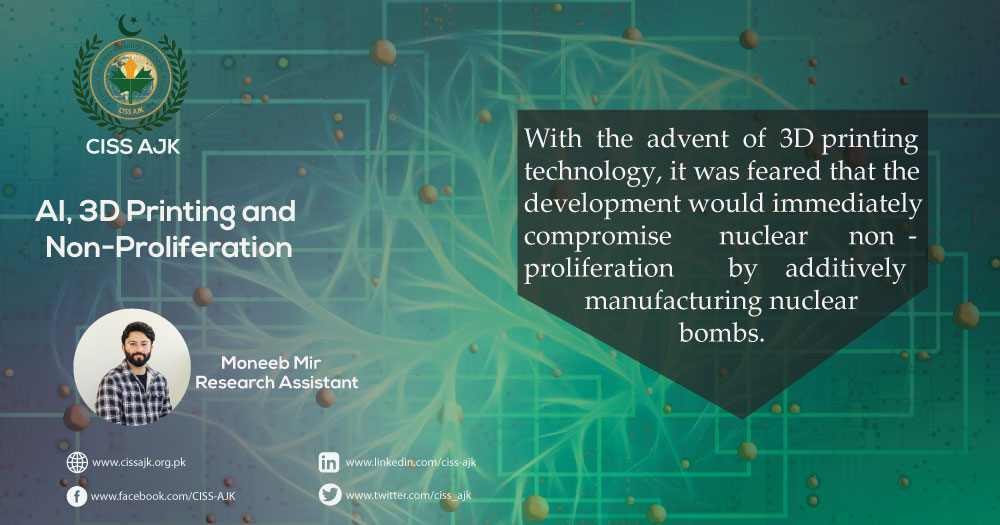794
The recent development involving the American aerospace startup Relativity Space sending the ‘world’s first 3D printed rocket’ into space has exposed faults in the mechanism of international nuclear non-proliferation and disarmament regime, reigniting a fresh debate on its makeover.
3D printing, like many other emerging technologies, has remained the talk of the town for many years. Also known as additive manufacturing (AM), 3D printing is a process of making three-dimensional solid objects from a digital file. Matthew Kroenig, who is Vice President and Senior Director of the Atlantic Council’s Scowcroft Center for Strategy and Security, writes in his research article, Exporting the Bomb: Technology Transfer and the Spread of Nuclear Weapons opines that “If building the bomb is like solving a giant jigsaw puzzle, one of the hardest parts is simply getting all the necessary pieces”.
With the advent of 3D printing technology, it was feared that the development would immediately compromise nuclear non-proliferation by additively manufacturing nuclear bombs. Nevertheless, such fears dampened given the expert opinion that even advanced machines cannot print weapon components without expert designs.
However, the sophistication that Artificial Intelligence (AI) brings along, is driving the potential for the technology further ahead. The ability to produce anything imaginable with the help of AI is about to usher in a ‘new industrial revolution’. The application of AI has already enabled industrial giants to overcome complex hurdles in designing. Industrial-scale 3D printers are already in use in the defense realm. According to Scientific American magazine, defense contractor Raytheon had a 3-D printer that could manufacture 80 percent of a missile. Los Alamos National Laboratory, which designed and built the world’s first nuclear weapons and maintains a large part currently using these machines to produce high explosives.
Retrospectively, during the mid-1990s, a scout David Hahn utilized household objects, and with the help of his scientific knowledge, he attempted to build an improvised nuclear reactor in his backyard. The police and Environmental Protection Agency stopped him before he was able to accomplish his goal. In today’s era, emerging technologies and revolutions in manufacturing, as well as computing, have already made projects like that of Hahn’s a lot more achievable. It is rather easy to be understood that if Hahn has access to a 3-D printer, he could have finished making a nuclear reactor before authorities had intervened.
In this way, it can be inferred that the technology could significantly increase the indigenous manufacturing capabilities of countries and as well as of non-state actors. Various components and materials needed to make a nuclear weapon, which is harder to be obtained because of the international export control regime, could be made additively with the help of AI.
Similarly, the autonomy of proliferators will augment manifolds when such technology will spread widely. As the dependence on imports reduces, the effectiveness of the international sanction regime would further be greatly undermined, which is a central non-proliferation instrument. This would further greatly attenuate development cycles and lead time to a great extent for indigenous nuclear programs, where it would need lesser time to make a nuclear weapon.
Given the cyber-automation of 3D printers, software, and 3D scanning technology, there can be an easy transfer of weapon know-how. Not to ignore the fact that the ‘footprint’ of production facilities for nuclear weapon parts will further diminish, which might make it difficult to detect the illicit making of a bomb. In this way, it is to be realized that as the world is grappling with the gravity of emerging technology, international non-proliferation measures need to be revamped. The pace of the change is too rapid and daunting that some of the biggest names in AI are warning about their own creations. They even went on signing a moratorium that called for a pause on AI training for a period of six months.
In order to give society some space to adapt AI and to ensure that AI creators take steps to make the technology more human-friendly.
The development further dents the already under duress nuclear non-proliferation treaty (NPT) based order while bringing uncertainty about the nuclear security of the world, as more technologies roll out. Therefore, action needs to be taken before it is too late.



